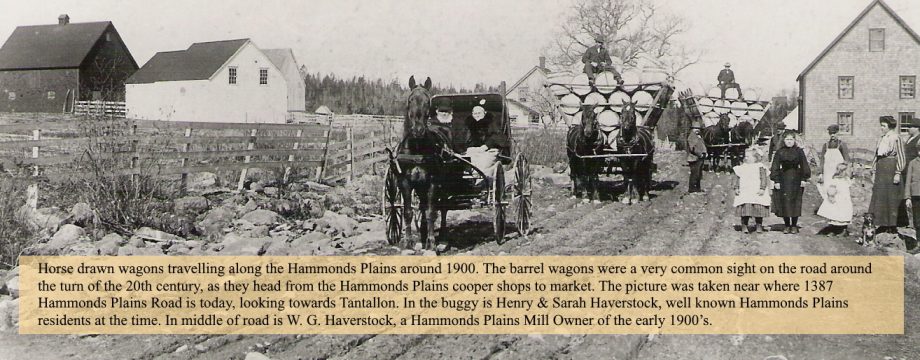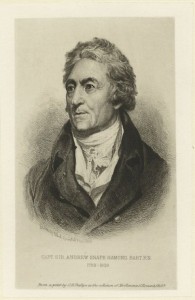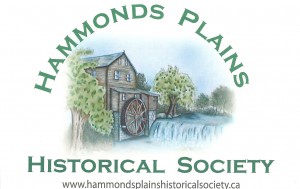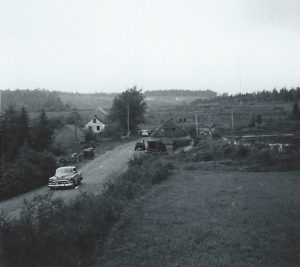Sir Andrew Snape Hamond, Lieutenant Governor of Nova Scotia 1738-1828
Andrew Snape Hamond was born on 17 December 1738 in Blackfield (London), England, the only son of Robert Hamond and Susannah Snape. His father Robert was a successful London merchant and ship owner. Andrew entered the Royal Navy in 1753. He served at sea during the Seven Years’ War. In 1763, Andrew married Cecilia Sutherland (no children). He was promoted Commander in 1765 and Captain on 7 December 1770. During the American Revolutionary War, he served as Captain of HMS Roebuck, of 44 guns. He was knighted at the close of 1778 for his distinguished conduct that year. In 1779 he married secondly, Anne, the daughter of Henry Greene, Esquire, of Hanwell Heath, Middlesex. During the war, HMS Roebuck was involved with most active sea engagements up to 1780. On return to England in that year, Sir Andrew was offered and accepted the posts of Lieutenant-Governor and Commander-in-Chief of Nova Scotia and Commodore and Resident Navy Commissioner at Halifax.
Sir Andrew and his family (wife Anne son Graham, and daughter Caroline) arrived in Halifax during the night of 29–30 July 1781, being sworn into office on the 31st. As Commander-in-Chief, his main concern was the defence of the province which included: the provision of an adequate militia, upgrading of defences, and the supply of masts for the navy. He also oversaw the building of a new 200 bed naval hospital at Halifax in 1782.
Sir Andrew’s tenure as lieutenant governor coincided with the beginning of the loyalist migration from the American colonies, and a proposal for settling the Port Roseway (Shelburne) area was made to him by New York Loyalists in August 1782. He approved the plan and promised his support, although he discouraged loyalists from trying to come before the spring. Nova Scotia was in fact completely unprepared for the loyalists in terms of food, building supplies, and available land. Large tracks of land had been previously granted, but were unoccupied and had to be escheated before settlement could begin.
On 8 July 1782, the home secretary had written to Sir Andrew informing him that John Parr had been appointed to succeed the absent Francis Legge as governor of Nova Scotia. Sir Andrew was surprised and embittered, having accepted the office of Lieutenant Governor “on the strongest assurances of succeeding to the Government.” John Parr was appointed Governor due to his influence with Lord Shelburne, the home secretary. He arrived in Halifax 5 October. Sir Andrew quickly realized that the province could not contain both of them, and thus resigned on 8 October.
The news of Sir Andrew’s resignation was greeted with surprise and genuine regret in the province. Five counties presented him with “addresses of approbation,” and the Council voted him a grant of 10,000 acres at the mouth of the Kennebecasis River near Saint John. The flood of southern Loyalist settlers began in the early fall of 1782, having to spend the winter on the commons and at Point Pleasant.
Sir Andrew remained in Nova Scotia performing his duties as Naval Commissioner until January 1783, when he left Nova Scotia with his family and household staff for England via Antigua, arriving home in June 1783 after a very difficult journey. On 10 December 1783, Sir Andrew was appointed first “Baronet of Holly Grove”, Berkshire, County. He chose for his “Hamond” arms, a design roughly based on the “Hammond” family arms of Kent and of the Isle of Wight. In 1785 he was promoted commodore and appointed commander-in-chief of the Nore (included the Medway River facilities and other east coast naval bases and depots), with headquarters at Chatham, Kent. He held this appointment for three years. In 1793 he was appointed Commissioner of the Navy Board for which he became Deputy – Comptroller of the Navy in February 1794, and on the death of the incumbent in August of that year, was made Comptroller for the subsequent 12 years. In 1794, Captain George Vancouver, during his charting of the Alaska coastline, renamed “Controller Bay”, at the southern end of Kayak Island, “Cape Hamond” after Sir Andrew. “Cape Hamond” is presently known as “Cape Saint Elias”.
Sir Andrew was elected in 1796 as one of eleven Elder Brethren of “Trinity House”, an ancient guild incorporated in 1514 by the King and located in Deptford-Stroud, Kent. From the beginning it was open to men and women interested in maritime safety. It is currently the Lighthouse Authority for the United Kingdom. Later in 1796, Sir Andrew was elected (twice, second time uncontested), as Member of Parliament for Ipswich. On 2 March 1797 he was elected a Fellow of the Royal Society. At that time, membership was restricted to working scientists and wealthy amateurs, and since the 1820s to only scientists. He resigned from Parliament and the navy in 1806 on the death of Prime Minister William Pitt (the younger). He retired with a pension of 1,500 pounds per annum. His retirement had been hastened by problems that developed over investigations involving accounting differences for naval funds between civil and naval authorities.
In 1809 Sir Andrew purchased an old estate at Terrington (now called Terrington St Clement), Norfolk. He rebuilt the estate and named it “Hamond Lodge”, now known as “Terrington Court”. He died at Terrington on 12 October 1828. Lady Anne died on 8 September 1838, Sir Andrew and Lady Anne are buried in nearby St Clement Church, a very large and beautiful 14th century Church built over Norman Abbey ruins. The family vault is one of only two in the church, located just below the organ. The “Hamond” arms have been incorporated in current village signs. In retirement and in death, Sir Andrew was considered a naval hero and a gentleman, respected by Parliament, his peers, and above all the British people.
The Hamond family name remains in Halifax Regional Municipality, misspelled as “Hammonds”. While in Halifax, Sir Andrew built a farmhouse just north of Fort Needham near the intersection of the present Devonshire Street and the former Gottingen Street. A road begun by Sir Andrew “from the foot of the Block house hill to the North Farm” eventually became known as Lady Hammond Road. In 1786, some 9,000 acres between Mill Cove, at the shores of Bedford Basin, and the head of St Margarets Bay were granted to 45 proprietors, who voted to call the settlement “Hamond Plains”. These were tokens of the high esteem in which Sir Andrew Snape Hamond and Lady Hamond were held by the society over which they had presided for so short a time. Sir Andrew’s son Graham became 2nd Baronet of Holly Grove on the death of his father. Sir Graham held the appointment of Admiral of the Fleet and had achieved the rank of Vice Admiral on retirement. Sir Andrew’s daughter Caroline married Lt Col the Hon Francis Hood.
![]()





